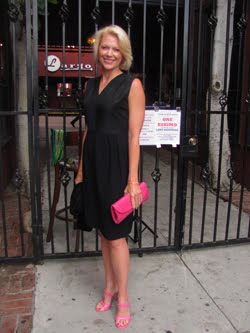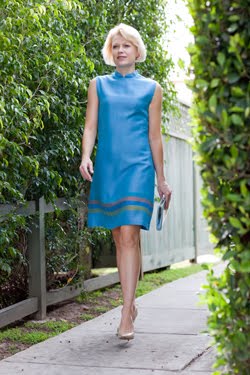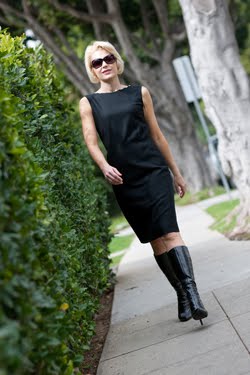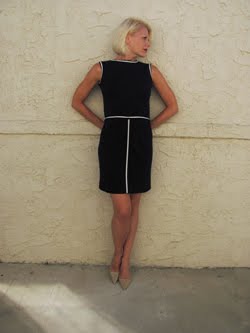My podcast with Turner Classic Movies is all about the style of the great costume designer Helen Rose. Of her 23 years at MGM--from 1943 to 1966--we discuss some of her best movie moments and wardrobes that are influential and personally significant for me. Check out all the costumes in the companion blogs here on GlamAmor:
--Mogambo (1953, blog done before the broadcast)
--Cat on a Hot Tin Roof (1958)
--Butterfield 8 (1960)
--The Courtship of Eddie's Father (1962)
All of these wardrobes are part of the same style story and great representations of what came to be Helen's classic style voice in clothing--colorful, clean lines, luxurious fabrications, and sophisticated yet sexy shapes. They also show her tremendous range--from rugged safari to glamorous gowns and furs--yet all with a singular style. These are qualities that I consider my own aesthetics and aspirations, and for these reasons Helen has become a role model to me over the years. In doing GlamAmor, I continue to be surprised at how often people take costume design in film for granted, so I wanted to share a little more about this special talent in the history of cinema.
1920s Chicago (above) and
inside one of its infamous nightclubs courtesy of LIFE magazine
In 1929, Helen moved to Los Angeles and married her sweet and supportive husband, Harry Rose. The universe continued to keep her connected with costume design, starting in sunny Southern California sewing and sketching period pieces for a Hollywood costume company. She then had the good fortune to go on to design for Fanchon and Marco, producers of national live stage shows that played in theaters before movie screenings. These shows were important testing grounds for many talented people who went on to become stars in the movies themselves--Judy Garland, Mae West, Doris Day, and Ginger Rogers are just some of the performers who started with Fanchon and Marco. Working with the company gave Helen a platform where she continued to get noticed. An admiring assistant ultimately gave her sketches to the right people at 20th Century Fox, who hired her as a costume designer until she was stolen away by MGM. Louis B. Mayer considered Fox Studios so much a competitor that he wanted to hurt them by giving Helen an offer she couldn't refuse. Little did she know that she would be paid to do nothing for many months until the mismanaged costume department finally figured out a way to utilize her talent. Ziegfeld Follies was her first credit at MGM.
By the late 1940s, Helen became the head of costume design for MGM and remained so until 1966. She took over the lauded position from Irene and Adrian before her, costume designers who needed only one name in the credits because their talent was so established. Adrian alone was a giant in the industry who only left when he wanted to start his own couture collection. His over-the-top glamour was famous and a huge part of the creation of the overall MGM look and brand. Think of his costume design in 1939's The Women, for example. He became particularly known for dressing Joan Crawford. He was responsible for her broad shoulders in clothing, a trick for making the petite Crawford look ten feet tall and a look so popular it became a 40s trend. Joan became so associated with the look that she took it with her always, including when she left MGM for Warner Brothers and did Mildred Pierce. Irene had far less of a unique artistic voice, but she was still intensely talented and created some absolutely beautiful costumes at MGM. Some of my favorites are many of Ginger Rogers' wardrobes and Lana Turner in The Postman Always Rings Twice.
When Helen took the helm as head costume designer at MGM, she exercised tremendous range due to her extensive experience and was completely capable of doing it all. Though I worship her later more minimalist style, she was equally talented in the out-and-out glamour that Adrian established and MGM was known for. After all, that was her background starting in Chicago and it remained close to her heart. With the talented teams at MGM, she was able in indulge in glamour like never before. But Helen recognized that the midcentury was bringing about cleaner and more classic lines and eventually she took costume design in her own direction. As I mention in the podcast, Helen became a bridge between costume design that was purely fantasy (e.g., Adrian) and costume design that became purely practical (e.g. many of the movies and television shows today). She established a timeless classic style, something that the average woman could really aspire to with its everyday elegance.
The ways that Helen achieved her style were her clever use of color, luxurious fabrics, and absolute attention to fit. Working with dancers through the years gave her an incredible education in the functionality of a garment and the associated importance of fit. Glamour was important, yes, but clothes had to move well on and with a woman. She learned about a garment's "recovery," or how a garment looks when a woman's motions are completed. What really set Helen apart from other costume designers is that she applied that knowledge throughout her career on actresses whether they were dancers or not. Not only did a costume have to look great while an actress was standing still, but Helen could make it fit just as well on an actress' moving body and recover beautifully even when she was just walking across a room.
Because she was known for always achieving Louis B. Mayer's one standing order to "just make them look beautiful" and treated everyone with great respect, Helen worked wonderfully well with all of her colleagues and clients. Many of the biggest were also personal friends--Elizabeth Taylor, Grace Kelly, Lana Turner, Lena Horne, Lauren Bacall, and Esther Williams were all considered like sisters. She was so close, in fact, that she frequently designed wedding gowns for MGM's actresses offscreen as well as on. She famously designed a wedding gown for Grace and Elizabeth as well as countless others. She did it so well that Zsa Zsa Gabor once said, "A beautiful Helen Rose chiffon dress, a little Dom Perignon, some caviar, and dammit, you're married again!"
The early days at MGM Studios (above) and
Helen's first movie for MGM, Ziegfeld Follies (1943)
The ways that Helen achieved her style were her clever use of color, luxurious fabrics, and absolute attention to fit. Working with dancers through the years gave her an incredible education in the functionality of a garment and the associated importance of fit. Glamour was important, yes, but clothes had to move well on and with a woman. She learned about a garment's "recovery," or how a garment looks when a woman's motions are completed. What really set Helen apart from other costume designers is that she applied that knowledge throughout her career on actresses whether they were dancers or not. Not only did a costume have to look great while an actress was standing still, but Helen could make it fit just as well on an actress' moving body and recover beautifully even when she was just walking across a room.
Helen's Oscar-winning wardrobes from
The Bad and the Beautiful (1952, above) and I'll Cry Tomorrow (1955)
Wedding by Helen Rose--Elizabeth Taylor and Nicky Hilton (above) and
I often think how challenging Helen's job must have been when her artistry demanded that so many be involved--all of her costume sketches required signatures from the producer, director, art director, cinematographer, and so on in order to be approved. It really speaks to the quality of her designs that so many made it through the process with such integrity. I believe that a large part of this has to do with the timeless and classic nature of her style. Stories abound of the actresses who kept Helen Rose costumes for their personal wardrobes. For instance, Elizabeth Taylor's mother once borrowed one of her daughter's 1940s dresses to wear to a party decades later. Not only was she still in style in Helen Rose, but Elizabeth's mom found she was also the most fashionable person in the room.
Not surprisingly, Helen started her own couture collection once she departed the studio system like many other costume designers before her. Buyers described her work as "beautiful, elegant, simple and wearable" and this clearly applies to her costume work as well. As Joan Crawford once wrote to her in those later days, "The women today are sadly in need of great designers like you who refuse to go along with the layer upon layer upon layer, and still design the classic look. The classicly groomed woman is a rarity today--but, oh, what a glorious sight she is when you do see her!"
How true those words are and they still apply today...I couldn't have said it better myself. Three cheers to the ultimate designing woman and my hero, Helen Rose!




























































































No comments:
Post a Comment